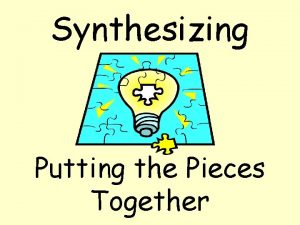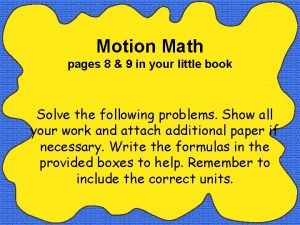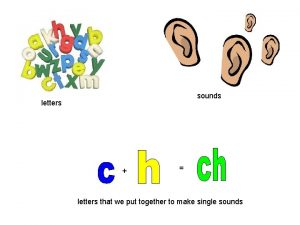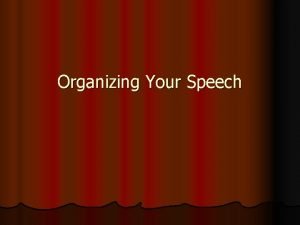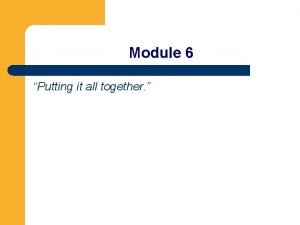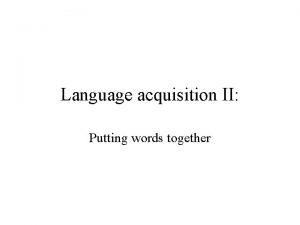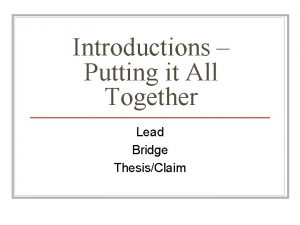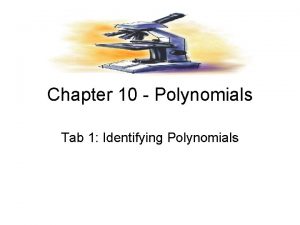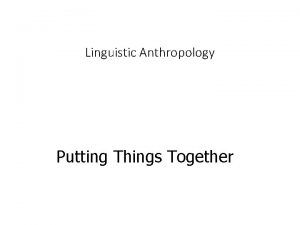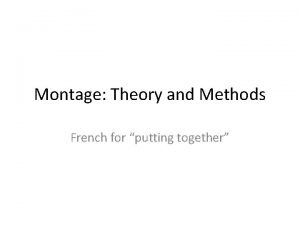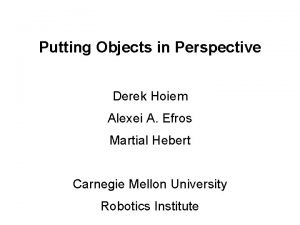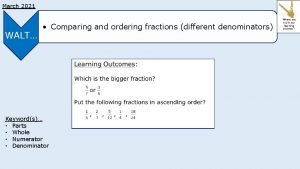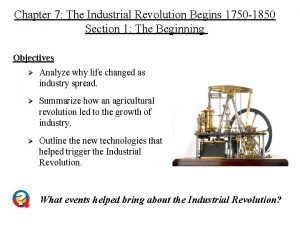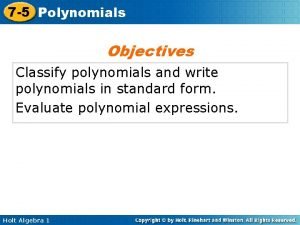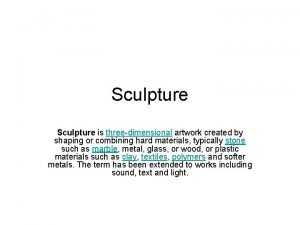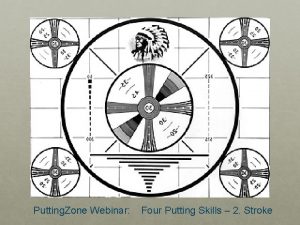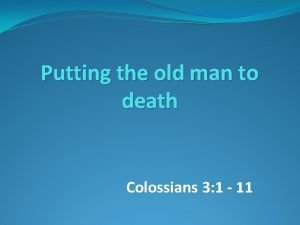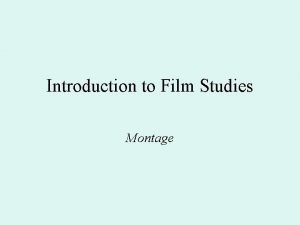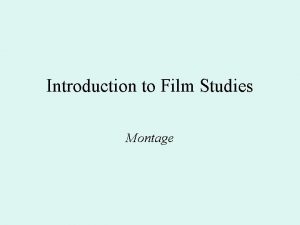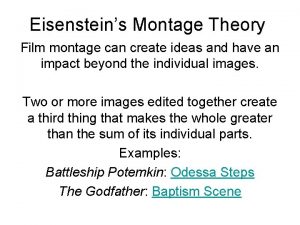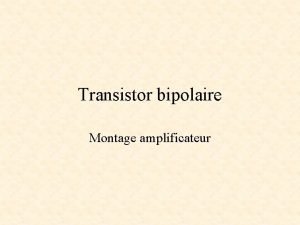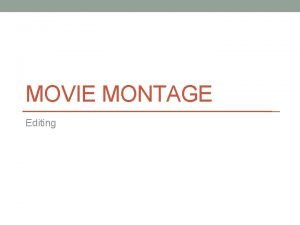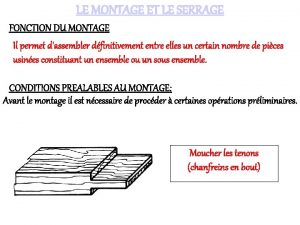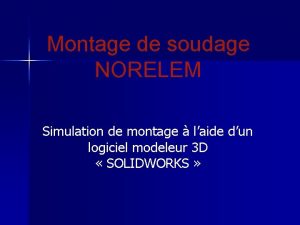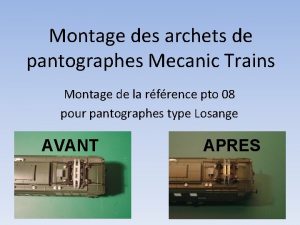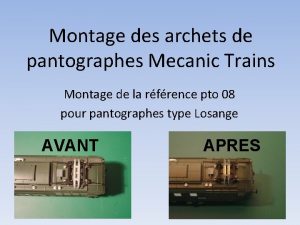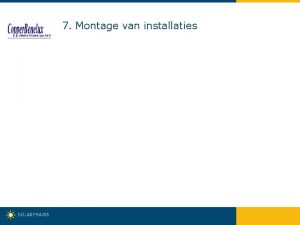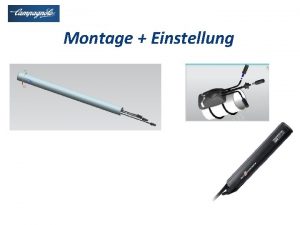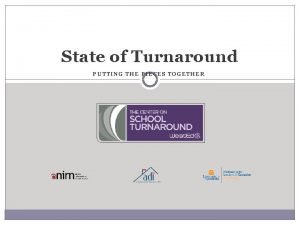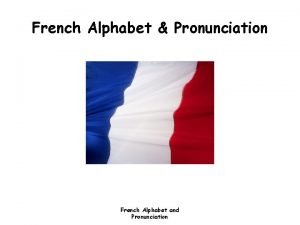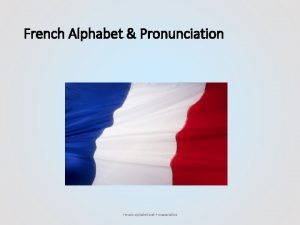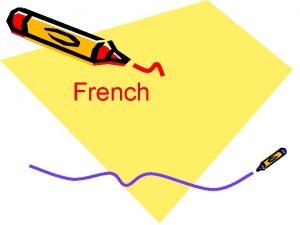Montage Theory and Methods French for putting together































- Slides: 31

Montage: Theory and Methods French for “putting together”

Opening • http: //www. youtube. com/watch? v=_g. Gl 3 LJ 7 v. Hc • Watch your clip and then respond to the following question: • What do you think the man in the film was thinking or feeling? Why?

a famous film experiment that was conducted by Russian filmmaker Lev Kuleshov. • • He gathered a group of people together and showed them a film of a man’s face (a famous Russian actor named Ivan Mozhukhin). Then, the film cut to a bowl of soup. When asked how the man felt, the audience replied: "Hungry. " Next, the audience was shown the exact same picture of the man’s face, then the film cut to a dead child. Next, the same image of the actor was juxtaposed with a reclining woman. The audience read a different meaning into Mozhukhin’s expression with each combination. In fact, even though it was the same image of the man's face every time, the audience was convinced his expression had changed and praised the man for his fine acting skills. In another experiment, Kuleshov spliced together another series of shots which had been filmed entirely out of sequence and in different times and places: a waiting man, a walking woman, a gate, a staircase, and a mansion. The audience read spatial and temporal "sense" into the sequence, deciding that they saw the man and the woman meeting in front of the gate at the same time. These experiments led many Soviet filmmakers to realize that the meaning of a film is not inherent in the images themselves, but rather in the juxtaposition of those images side by side. This led to the development of the concept of "montage" in film.

Montage, or collision editing • done by splicing together a rapid sequence of carefully selected shots to evoke a specific emotional or intellectual response. The Russians' premise was that each shot derived meaning from the context in which it was placed. • If the context changed, the meaning of the shot and the sequence also changed. • For example, Eisenstein once combined shots of a poor woman and her undernourished child seated at an empty table with shots of an affluent, overweight man seated at a table filled with food. His intent in combining those shots was to evoke images of the oppression of the poor by the wealthy. • Had Eisenstein shown one series of shots without the other, the meaning would have been quite different. • Montage, in the modern sense of the word, often refers to sequences where several shots have been edited together to compress a series of events that happen over time (e. g. , sequences of young couples falling in love, scenes with flying calendar pages, etc. ).

Modern examples • • http: //www. youtube. com/watch? v=q. Mk-2 q. Qei. Tw Rocky Training Montage Marie Antoinette http: //www. youtube. com/watch? v=Zn 93 ABppv. XE

Soviet Montage • Soviet montage theory is an approach to understanding and creating cinema that relies heavily upon editing. Although Soviet filmmakers in the 1920 s disagreed about how exactly to view montage, Sergei Eisenstein in "A Dialectic Approach to Film Form“ noted that montage is "the nerve of cinema, " and that "to determine the nature of montage is to solve the specific problem of cinema. " While several Soviet filmmakers, such as Lev Kuleshov, Dziga Vertov, and Vsevolod Pudovkin put forth explanations of what constitutes the montage effect, Eisenstein's view that "montage is an idea that arises from the collision of independent shots" wherein "each sequential element is perceived not next to the other, but on top of the other" has become most widely accepted

Metric • Define: editing follows a specific number of frames (based purely on the physical nature of time. ) cutting to the next shot no matter what is happening within the image. • effect: elicits the most basal and emotional of reactions in the audience. • Example: example from Eisenstein's October • http: //www. youtube. com/watch? v=l-s_Ovf. Akko

Rhythmic • Define: cutting based on time, but using the visual composition of the shots -- along with a change in the speed of the metric cuts. . Once sound was introduced, rhythmic montage also included audible elements (music, dialogue, sounds). • effect: more complex meanings than what is possible with metric montage • Example: http: //www. youtube. com/watch? v=t 7 WRkp. T qp 3 s • http: //www. youtube. com/watch? v=Tg 89 T 4 -Momc

Tonal • Define: uses the emotional meaning of the shots - not just manipulating the temporal length of the cuts or its rhythmical characteristics • effect: to elicit a reaction from the audience even more complex than from the metric or rhythmic montage. • Example: a sleeping baby would emote calmness and relaxation • http: //www. youtube. com/watch? v=Mi. PS 3 HN 8 t 7 Q

Overtonal/Associational • Define: the accumulation of metric, rhythmic, and tonal montage= syntehsis • effect: to synthesize its effect on the audience for an even more abstract and complicated effect. Example:

Intellectual • Define: - uses shots which, combined, elicit an intellectual meaning. • Effect: symbolic association/ metaphor meaning does not exist in the individual shots; it only arises when they are juxtaposed • Example: In The Godfather, during Michael's nephew's baptism, the priest performs the sacrament of baptism while we see killings ordered by Michael take place elsewhere. The murders thus "baptize" Michael into a life of crime.

In a nut shell… • Metric Montage= Determined solely by the lengths of shots. • Rhythmic Montage=The cutting rate was based upon the rhythm of movement that occurs within the shot. • Tonal Montage=Cutting determined by the emotional tone of the shots. • Overtonal Montage=A combination of Metric, Rhythmic and Tonal montage. • Intellectual Montage=Determined by the conflictjuxtaposition of accompanying intellectual affects. • http: //www. youtube. com/watch? v=Mz. XFSBl. QOe 4

• Man with a movie camera • http: //www. youtube. com/watch? v=Iey 9 YIbra 2 U • Dziga Vertov's Man With A Movie Camera is considered one of the most innovative and influential films of the silent era. Startlingly modern, this film utilizes a groundbreaking style of rapid editing and incorporates innumerable other cinematic effects to create a work of amazing power and energy. Film pioneer Dziga Vertov uses all the cinematic techniques available at the time - dissolves, split screen, slow motion and freeze frames. This movie is silent!

Analysis of the Odessa steps sequence • A domestic flop in the Soviet Union, Potempkin was loved by German audiences, although the armed forces were forbidden to see it for fear of mutiny, as were Pennsylvanian audiences on the grounds that it gave American sailors 'a blueprint as to how to conduct a mutiny. When it was eventually screened in the US in 1926, Chaplin declared it to be 'the best film in the world'. In France the authorities burnt all copies they could find - it received only a limited art house screening at Paris film clubs. Despite being banned in the UK until 1954, The Battleship Potemkin has rarely been out of the annual BFI critics' top ten list, and only then when another Eisenstein film has been voted in.

• The film documents an event that helped precipitate the 1905 Revolution which shook the Tsarist regime. The battleship Potemkin is a microcosm of Russian society. The ship's officers, doctor and priest - all representing the ruling power structure - pile abuse on top of abuse until maggot infested meat and a threatened mass execution push the sailors to mutiny. The mutineers eventually find sanctuary at the Black Sea port of Odessa, the setting for the film's penultimate sequence, showing Odessa's population supporting the Potemkin mutineers anchored in the bay. The sudden appearance of Tsarist soldiers abruptly reverses the joyous mood as the troops mercilessly advance, shooting everything that moves. Rhythm (cutting) builds with tempo (the pace of action within the frame) as the soldiers descend the steps in relentless solid formation behind the chaotically scattering crowd. This descending action travels left to right across the screen for rapidity (because we read left to right, top to bottom in English, our brains process screen information better in this direction, enabling us to read the images faster). •

• In this sequence, the Czar's army is quashing an uprising. Eisenstein uses editing to show the fear of the people, their escalating panic, the tragedy of innocent bystanders as a baby in a carriage careens helplessly down the steps, and the intensifying threat of the soldiers, their guns and artillery. • Watch the Untouchables---this is done here too

• file: ///H: FilmEditing. Potemkin. ppt • file: ///H: FilmSov. Montage. ppt

Soviet Montage and The Formalist Tradition • Key Terms and Concepts: - Sergei Eisenstein thought the conflict of two shots (shot A: thesis, and shot B: the antithesis) creates a whole new idea (shot C: synthesis). -Eisenstein thought linked shots were mechanical and inorganic. - Eisenstein also thought the transition between shots should be rough, sharp, jolting, and violent. Smooth cuts were an opportunity lost to show harsh collisions between two ideas, or shots. - Cuts should be made at a shot’s maximum point of tension or climax. Thus, editing rhythm should be dynamic, with constant succession of climaxes and tensions. -- Shots with contrasting volumes, durations, shapes, designs, and lighting intensities should collide against each other.

• V. I. Pudovkin thought emotions should be conveyed with physical images, with series of shots with locale and objective correlatives. - Eisenstein thought images should include images that are thematically or metaphorically relevant, whether they are in the locale or not. • Dialectical- the result of the conflict and synthesis of opposites

• In the 1920's, soviet film makers expanded Griffith's associational principles and established theoretical premises for thematic editing, or montage -Pudovkin states that Griffith's use of the close up is too limited and is merely an interruption, offering no meaning of its own -Pudovkin insisted that each shot should make a new point. Through the juxtaposition of shots, new meanings can be created -Lev Kuleshov, Pudovkin's mentor believed that ideas in cinema are created by linking fragmentary details to produce a unified action - Kuleshov believed that the emotion of a film is not produced by the actors performance, but by associations brought about the juxtapositions. In a sense the viewer creates the emotional meanings, once the appropriat objects have been linked together by the film maker -Values of the film maker would inevitably influence the manner in which reality is percieved

Critical Questions for Review • 1. Is there emotion conveyed through fast, explosive cuts? If so, what? 2. How did Eisenstein's ideas differ from Pudovkin? 3. What kind of images are metaphorically or thematically linked if you are trying to express sadness? 4. Eisenstein thought linked shots were mechanical and inorganic. Are they? Why or why not? 5. What are the associated principles and established theoretical premises for thematic editing called?

scene from Pudovkin's film Mother • mother marches with her comrades toward the prison. • Read the following quote from Jonathan Jones' article about Pudovkin: • "Pudovkin's most ambitious montage, later in the film, has few equals in any cinema. Mother is full of shots of the Russian landscape. At first these seem almost random; only in the final march on the prison does the full power of the imagery hit home. As the mother and comrades march towards the prison, it's spring and the snow is starting to melt. Cut to an immense frozen river, its surface cracking, splitting. This is a piece of Marxist poetry. The river is history, flowing unstoppably, breaking out of the carapace of ice under which it has been trapped through the long tsarist winter. It's awesome, scary. When the son breaks out of jail he's chased down to the river's edge. Trapped! His only chance is to jump on a block of ice, let the river carry him, and that's what he does. He seems doomed as the ice is carried very fast - he'll never make it - but he does, and the film moves to its historically-determined climax. “

• Odessa Steps sequence from Eisenstein's Battleship Potemkin. Point out some of the diametrically-opposed shots to the students. • Montage clip from training montage in Rocky= a use of montage in contemporary Hollywood

• Analyze the Odessa steps sequence from Battleship Potemkin and discuss in detail how it illustrates what the “camera eye” together with editing shows. How does Eisenstein makes use of his collision montage in which he “replaced the conventional logic of dramatic action by images arbitrarily chosen to create the maximum psychological impact on the audience” • Think about how Eisenstein also uses montage in this sequence to expand compress time with dramatic results.

Example: • The beginning of the sequence is marked by the civilians cheering the mutinous sailors, soon after which the massacre begins. In one shot a women stands with her dead son in her arms while the Cossack soldiers approach from the top of the stairs. The position of the women is center screen with the Cossacks dominating the upper third, while murdered bodies litter the stairs between the two. This foreground, middle ground and background composition reveals what has happened (murdered bodies – middle ground), who is responsible (Cossack soldiers – background) and who might be next (women – foreground), this is referred to as conflict of planes (Fourie, 2001: 202). The streak of light that emerges between the women and the soldiers separates the two sides of dead bodies (conflict of lighting) and create a sense of understanding between the women and her antagonist. The bodies that scatter the s taircase represent a graphic contrast in that the horizontal lines created by the stairs and being “broken” by the lifeless figures that now lie there. This graphic conflict deemphasise the stairs as a whole and singles out the path between the women and the approaching soldiers, again this creates a strong visual link between foreground and background. Through the elements described this shot creates a sense of hope as the women pleads with the soldiers to stop the bloodshed, while at the same time it still maintains a sense of inevitability about the women’s fate.

• • • “Odessa Steps” and the Eisenstein’s Theories: An analysis The montage sequence of the “Odessa Steps” is the most significant example of a montage in Potemkin in which Eisenstein makes use of his collision montage in which he “replaced the conventional logic of dramatic action by images arbitrarily chosen to create the maximum psychological impact on the audience” (Turning points in History: 75). Eisenstein also uses montage in this sequence to expand compress time with dramatic results. The beginning of the sequence is marked by the civilians cheering the mutinous sailors, soon after which the massacre begins. In figure 1. 1 a women stands with her dead son in her arms while the Cossack soldiers approach from the top of the stairs. The position of the women is centre screen with the Cossacks dominating the upper third, while murdered bodies litter the stairs between the two. Thisforeground, middle ground and background composition reveals what has happened (murdered bodies – middle ground), who is responsible (Cossack soldiers – background) and who might be next (women – foreground), this is referred to as conflict of planes (Fourie, 2001: 202). The streak of light that emerges between the women and the soldiers separates the two sides of dead bodies (conflict of lighting) andcreate a sense of understanding between the women and her antagonist. The bodies that scatter thestaircase represent a graphic contrast in that the horizontal lines created by the stairs and being “broken” by the lifeless figures that now lie there. This graphic conflict de-emphasise the stairs as a whole andsingles out the path between the women and the approaching soldiers, again this creates a strong visuallink

• look for examples of montage, or collision editing, in the films you view. Make notes about the images, the ways in which they were combined, and the effects they created. Can you identify examples of jump cuts, reaction shots, places where time has been compressed through editing, or places where space has been manipulated through editing?

“Me” Video: construct a short film that introduces you. • One minute video. Portray yourself in film • Choose images that represent the things that are most important to you (images that define you) • Choose images that represent your “super-self” (images that reveal what you’d like to be) • Questions to ask before you shoot • What defines you? • What are your interests? • What are your objectives in life? • What is important? What is important to you? • What do you want to do? • Think about metric montage (all shots are equally long) • Think about accelerated metric montage (the shots get progressively shorter)

assignments • Film terms test on Thursday • Group film on editing cuts: cross-cutting (parallel editing, ) eye-line match, shot/reverse shot, POV shot, match on action. (quiz grade Friday)

Editing Analysis • Use the following questions to respond to each of the video clips posted to this page. Editing Questions for Film Analysis: 1) How much cutting is there and why? 2) Are the shoots highly fragmented or relatively lengthy? 3) What is the point of the cutting in each scene? To clarify? TO stimulate? To lyricize? To create suspense? To explore an idea or emotion in depth? 4) Does the cutting seem manipulative or are we left to interpret the images on our own? 5) What kind of rhythm does the editing establish with each scene? 6) Is the personality of the filmmaker apparent in the cutting or is the presentation of shots relatively objective and functional? 7) Is editing a major language system of the movie or does the film artist relegate cutting to a relatively minor fraction? 8. What style of editing does the clip represent and why? Sequence shot / Cutting to continuity / Classical Cutting /Thematic Montage/ Abstract

• First Film to View Un Chien Andalou • 3 rd Film for Editing Analysis Apocalypse Now
 After putting the pieces together, what do they look like?
After putting the pieces together, what do they look like? Putting it all together motion answer key
Putting it all together motion answer key Letters put together
Letters put together Package mypackage; class first { /* class body */ }
Package mypackage; class first { /* class body */ } Strategic organization means putting a speech together
Strategic organization means putting a speech together Practice putting it all together part 1 fill in the blank
Practice putting it all together part 1 fill in the blank Putting two words together
Putting two words together Introduction bridge examples
Introduction bridge examples Putting it all together
Putting it all together Putting the pieces together case study answer key
Putting the pieces together case study answer key Putting things together is called
Putting things together is called Rhythmic montage
Rhythmic montage Soviet montage
Soviet montage Marco koper
Marco koper A-wax pattern recognition
A-wax pattern recognition Putting-out system
Putting-out system What is nasreen putting chocolate on?
What is nasreen putting chocolate on? Putting-out system
Putting-out system Putting-out system
Putting-out system Physical rate fences
Physical rate fences Putting objects in perspective
Putting objects in perspective Oncology nursing society putting evidence into practice
Oncology nursing society putting evidence into practice The order of putting on ppe
The order of putting on ppe Ordering fractions
Ordering fractions Putting people first 2007
Putting people first 2007 Putting-out system
Putting-out system Classification of polynomial according to degree
Classification of polynomial according to degree Putting the enterprise into the enterprise system
Putting the enterprise into the enterprise system A process in sculpture putting additional parts
A process in sculpture putting additional parts Putting zone
Putting zone Putting to death the old man
Putting to death the old man Putting the enterprise into the enterprise system
Putting the enterprise into the enterprise system
